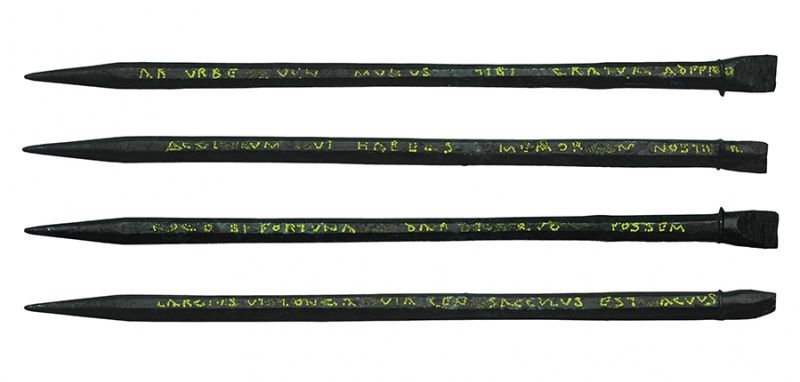
"I have come from the City. I bring you a welcome gift with a sharp point that you may remember me,” reads the Latin inscription on the 2,000-year-old iron stylus. “I ask, if fortune allowed, that I might be able [to give] as generously as the way is long [and] as my purse is empty." The “City" almost certainly refers to Rome, and the souvenir stylus essentially boasts a more flowery version of today’s “I went to Rome, and all I brought you was this pen.”
The stylus dates to around 70 CE—about 20 years after the founding of Roman Londinium, a decade after a Celtic uprising burned it to the ground and about 50 years before the first stones were laid for Hadrian’s Wall. It’s among 14,000 artifacts unearthed during the construction of Bloomberg’s European headquarters starting in 2013, and conservators are finally ready to put it on display.
Pre-Bloomberg
The site where the stylus was found stands on the banks of the ancient River Walbrook, a tributary of the Thames that now flows beneath the city’s streets. Before London officials culverted and covered the river during the 1400s, it flowed through the center of London, and before that, it bisected Roman Londinium.
In 70 CE, London would have been a rough-looking frontier community of low wooden buildings, in sharp contrast to the brick and marble of Rome. But London was already a bustling hub of commerce and trade thanks to the River Thames and its tributaries, including the Walbrook. Ships travelled up and down the river, loading and unloading their cargoes at warehouses along its banks. Merchants conducted a steady flow of trade in those low wooden buildings.
Even way out here on the northwestern frontier, strong cultural and economic ties bound London to Rome and the rest of the Empire. In the mid-20th century, archaeologists unearthed a temple to Mithras—an Iranian god of justice and contracts who many Roman worshippers adopted around 100-200 CE—along the eastern bank of the Walbrook. The city also had several Roman-style baths, an amenity that turned up even at forts along the very edge of Rome’s border with modern Scotland.
These finds speak to a reality of this ancient world: people travelled constantly from North Africa and across Europe along the Roman road system, and then by ship to London, bringing ideas and beliefs with them. One of those travelers also seems to have brought a cheap souvenir for a friend back home.
-
Artifacts from the Bloomberg site are on display in a museum inside the headquarters; others, including the stylus, are part of an exhibition at the Ashmolean Museum in Oxford.Museum of London Archaeology
-
Excavations at the Bloomberg site began in 2013.
Very relatable content
The stylus would have been used to etch letters in a layer of wax held in a wooden tablet. Etching away the wax would reveal the pale wood beneath, making the letters stand out against the black wax background. Archaeologists found about 405 of these wax tablets at the Bloomberg site in 2016 and 2017; the several dozen they’ve translated so far reveal ancient business dealings, legal quarrels, and the logistics of rebuilding London after Boudica and her Celtic army burned most of it to the ground in 60 CE. In fact, some of those tablets contain the oldest written records from Roman Britain.
Archaeologists unearthed about 200 styluses from the site, but this corny little souvenir from Rome is the only one with an inscription. In fact, it’s one of just a handful of inscribed styluses from anywhere in the ancient world. It’s impossible to say for sure whether that’s because details like tiny lettering simply haven’t survived time and decay or because stylus inscriptions were actually rare in the Roman Empire. If this one was considered a cheap souvenir, though, it suggests it may have been a pretty common thing.
Cheap though it may have been, the ancient souvenir certainly does have a sharp point. It shows us the links between far-flung parts of the Roman Empire, and it reminds us that ancient people had the same personalities, quirks, and (occasionally terrible) senses of humor as people today.
Tourism, in particular, hasn’t changed much in two or three millennia. Archaeologists working in Egypt’s Valley of the Kings found Greek and Latin graffiti in the tomb of Pharaoh Ramses VI, who ruled from 1132 to 1125 BCE. They say it dated from around 332 BCE, when Alexander the Great conquered Egypt, to the fall of the Roman Empire around 476 CE.
Many of the hastily etched comments would look right at home among modern Yelp reviews. “I visited, and I did not like anything except the sarcophagus!" wrote one visitor. "I cannot read the hieroglyphs!” complained another. The tomb walls even contain comments on the original “posts” from other visitors: “Why do you care that you cannot read the hieroglyphs?” some ancient Roman visitor wrote in response to the comment above. “I do not understand your concern.”
reader comments
141